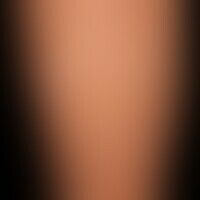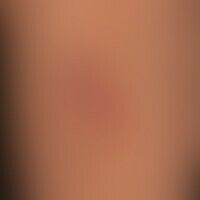Image diagnoses for "Leg/Foot"
395 results with 1158 images
Results forLeg/Foot

Psoriasis (Übersicht) L40.-
Psoriasis of the feet: here partial manifestation in the context of generalised psoriasis.

Lipedema R60.9
Typical collar formation in the joint regions in lipedema, in this case also incipient secondary lymphedema with swelling of the back of the foot.

Maculopapular cutaneous mastocytosis Q82.2
Urticaria pigmentosa: about 0.5-1.0cm in size, disseminated, oval or round, brownish-red spots. only when rubbed, increased redness of the spots with accompanying itching. also with warm showers or baths, increased redness and clearly palpable elevation of the lesions.

Folliculotropic mycosis fungoides C84.0
Mycosis fungoides follikulotrope: generalised clinical picture; smooth plaques that dissect at the edges, with clear follicular involvement. Moderate itching.

Vitiligo (overview) L80
Vitiligo: multiple roundish or circine vitiligo foci, with the credible assurance that a melanocytic nevus previously existed in each "round focus" (see above).

Hypertrophic Lichen planus L43.81
Lichen planus verrucosus. highly itchy,verrucous plaque on the left back of the foot, which has remained unchanged for years. a red-violet seam is visible in all parts of the plaques.

Angiokeratoma circumscriptum D23.L
Angiokeratoma circumscriptum: Vascular (venous) malformation of the skin (and subcutis) with circumscribed, aggregated moderately firm, blue-grey verrucous, painless plaques and nodules; varicosis of the surrounding area.

Idiopathic guttate hypomelanosis L81.5
Hypomelanosis guttata idiopathica: Disseminated, small spot depigmentations in the area of the lower leg extensor side.

Keratosis pilaris Q80.0
Keratosis follicularis: Comedone-like, follicularly bound papules in the area of the thigh.

Neurofibromatosis (overview) Q85.0
Classical (type I) neurofibromatosis: circumscribed dewlap formation.

Papillomatosis cutis lymphostatica I89.0
Papillomatosis cutis lymphostatica: massive findings with papillomatous growths in the heel region, on the back of the foot and toes; chronic lymphedema after recurrent erysipelas.

Contact dermatitis toxic L24.-
Contact dermatitis toxic: Detail enlargement: Severe hyperkeratosis on reddened skin as well as isolated small rhagades and erosions on the left ankle of a 46-year-old patient.

Lichen planus ulcerosus L43.8
Lichen (ruber) planus ulcerosus: extensive infestation of the feet with verrucous and crusty deposits and therapy-resistant deep ulcers with rough edges.

Livedovasculopathy L95.0
Livedovasculopathy: bizarre, very painful ulcers and hemorrhagic plaques in the area of both malleoli as well as flash-figure-like vascular drawing










